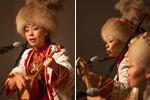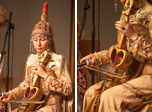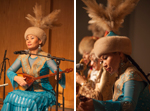
PROGRAM NOTES
The Bardic Divas: Women's Voices from Kazakhstan
Listen Now
download
Subscribe (itunes)
Subscribe (rss)
help
Program
The Bardic Divas
Women’s Voices from Kazakhstan
Ulzhan Baibosynova, dombyra and vocal
Ardak Issataeva, dombyra and vocal
Raushan Orazbaeva, qobyz
This podcast was recorded live in concert at the Freer Gallery of Art on October 6, 2012, in conjunction with the exhibition Nomads and Networks: The Art and Culture of Ancient Kazakhstan. It is made possible through support from the Thaw Charitable Trust and by funds from the Smithsonian Women’s Committee.
| Title | Time |
|---|---|
| Ak–Bayan | 0:00-3:32 |
| Lyrical song Sandugash (Morning Song Bird) Performer: Ardak Issataeva Text and music: Yestai (19th century) A lyrical song about unrequited love, set in the Kazakh countryside |
3:43:-7:21 |
Instrumental music (küi) performed on the qobyz |
7:30-11:01 |
|
Folk song arrangements Goi-Goi (Lament of the Blind Togzhan) Performers: Ulzhan Baibosynova and Raushan Orazbaeva |
11:12-16:50 |
| Oral poetry (zhyraulik) Bastau (Introduction) Performer: Ulzhan Baibosynova Text and music: Zhienbai-zhyrau (1864–1929) Bastau is from the repertoire of zhyrau, Kazakh bards who traditionally have been men. Ulzhan Baibosynova is one of a small number of Kazakh women who publicly perform the zhyrau’s repertoire of both short and long epic poems. Every zhyrau has a bastau, or introductory poem, that is sung before the performance of longer poems as a way to summon inspiration and to build rapport with listeners. Zhyrau use a raspy, guttural vocal timbre to perform various genres of oral poetry. They accompany themselves on the dombyra, a two-stringed, long-necked lute. Ulzhan Baibosynova learned this bastau from Bidas Rustembekov, a well-known zhyrau who lives in the vicinity of Qyzylorda in central Kazakhstan. Bidas Rustembekov learned it from his father, Rustembek-zhyrau, who learned it from his own father, Zhienbai-zhyrau, the composer of the bastau. Lyrics: |
17:01-19:06 |
| Zhonyp Aldy (Carved, Polished) Performer: Performer: Ardak Issataeva Text and music: Birzhan-sal Qozhagululy (1834–1897) Birzhan-sal was one of the best-known figures of nineteenth-century Kazakh music. Sal is an honorific title bestowed on bardic singer-songwriters, who not only were masters of their art but also were chivalrous and charismatic celebrities analogous, perhaps, to the troubadours of medieval Europe. An explanation of the title Zhonyp Aldy unfolds in the text and conveys the idea that, as unique, completely sculptured works of art, lyrical songs must be carefully carved or polished. |
19:20-22:04 |
| Instrumental music (küi) performed on the qobyz Zhez Kiik (Copper Antelope) Performer: Raushan Orazbaeva Composer: Yqlas Kazakhs traditionally believed humans should not kill animals simply for sport. Legend has it that if a hunter killed more antelopes than was necessary for food, a copper antelope would appear before him. If a hunter shot an arrow at this copper antelope, the arrow would bounce back and kill the hunter. The music of this küi represents the beautiful and sacred antelope. |
22:14-24:58 |
| Oral poetry (Zhyraulik) Ker-ogly (Son of the Grave) Performer: Ulzhan Baibosynova Ker-ogly belongs to the group of early Turkic epics whose origins are linked to the Oghuz Khanate of the tenth and eleventh centuries. It directly conveys the historical memory of the twenty-four ancient tribes of the Oghuz state, among which the Teke Jaumit tribe was one of the strongest. In the Kazakh version of the epic, Ker-ogly belongs to the Teke Jaumit lineage. Thus, the historical memory of the many wars between the Turkmen and the Persians that occurred over the centuries was not forgotten. The epic contains different chronological layers, ranging from mythological time to specific historical events of the sixteenth and seventeenth centuries. In this brief excerpt, Ulzhan Baibosynova recounts how Raushanbek and Gazhdenbek escape from their enemy by riding together on a fast horse that brings them safely home. |
25:06-33:27 |
| Lyrical song Oi Jailau (Oh, Mountain Pastureland) Performer: Ardak Issataeva Composer: Kenen Jailau is a term for an alpine pastureland—a common theme and reference in nomadic music. |
33:42-36:03 |
| Instrumental music (küi) performed on the qobyz Akku (White Swan) Performer: Raushan Orazbaeva Composer: Yqlas Traditional Kazakh spirituality holds that the souls of the dead are transformed into swans that fly far away. To this day, swans are important totems among the Kazakhs. When a swan flies over a house, the occupants offer a ritual farewell. Akku represents the voice of a swan and the sound of its wings flapping on the water as it takes off. |
36:10-41:58 |
| Oral poetry (zhyraulik) Talim Performer: Ulzhan Baibosynova and Raushan Orazbaeva Text: Turmagambet (1882–1939) Music: Zhienbai-zhyrau When the Kazakh epic singer Zhienbai-zhyrau taught this piece to his son Rustembek, from whom Ulzhan Baibosynova learned it, he called it naqpa-naq—to sing precisely and loudly—a performance style exemplified in Ulzhan’s rendition of Turmagambet’s lyrics. |
42:10-44:31 |
| Folk song medley: Erkem Ai, Qüralai, and Qogalai Performers: Ulzhan Baibosynova, Raushan Orazbaeva, and Ardak Issataeva In this lyrical and romantic folk song, the names of young girls serve as the titles of the different sections. |
44:46-53:35 |
Listen Now
download
Subscribe (itunes)
Subscribe (rss)
help
Notes
Music of the Kazakhs
Central Asia’s history has been shaped by its strategic position at the intersection of two great axes of civilization. One axis points southwest, toward the sophisticated urban culture of Iran. The other axis points northeast, to what has been called Turan—the nomadic world of the Inner Asian steppe, where pastoralists belonging to myriad Turkic and Mongolian clans created a succession of powerful empires. This nomadic world, and the worldview that emerged from it, still echo strongly in Kazakh musical traditions.
Among the Kazakhs, as in other historically nomadic cultures in Central Asia, the consummate traditional entertainer was the bard. Using modern parlance, bardic traditions might be called “performance art,” a combination of entertainment, social commentary, and personal philosophy delivered in an affecting and accessible musical language. Kazakh music includes a variety of bardic traditions, of which the best known is the performance of oral epics. Some epic tales in Central Asia extend as long as thirty times the length of Homer’s Iliad.
These narratives, along with instrumental pieces whose wordless melodies and rhythms relate beloved stories through a kind of musical onomatopoeia, all reflect a nomadic sensibility. Traditional nomadic religion ascribes spiritual power to a range of natural phenomena and living creatures, and nomadic music and sound-making often serve as a means of representing and accessing the power of spirits. Indeed, while Islam spread relatively easily to the sedentary parts of Central Asia, the nomadic population often resisted adopting it, thus preserving elements of more ancient beliefs related to shamanism (the practice of ritual specialists traveling to the spirit world), ancestor worship, and animism (the belief that all of reality is pervaded or inhabited by spirits or souls).
The physical challenges of nomadic life, communal herding chores, and the necessity of sharing living space (in the circular felt-covered tents that provide nomads with sturdy yet portable housing) enforced social contact between men and women and assured mixed audiences for social events. This tradition of shared work and social space has perhaps contributed to the significant present-day role of female musicians in historically nomadic cultures.
Some of the musical styles and genres represented in this concert are specific to female performers and have typically been presented within a social milieu restricted to women. Other styles and genres were once overwhelmingly the province of men. These latter items include the performance of oral poetry—zhyraulik—whose performers, called zhyrau, sing in a raspy, guttural vocal style that evokes the legendary and magical world of epic heroes. They also recall lyrical songs performed in the style of troubadours known as sal or seri.
Epic poetry, an ancient tradition among many Turkic peoples, was associated with beliefs in animal spirit-patrons and ancestor spirits. The Kazakh zhyrau was not just a performer of beautiful oral stories but also an individual endowed with spiritual power who could foresee the future and foretell the outcome of events. Since the fifteenth century, when Kazakh statehood was established, zhyraus have occupied an important position in society, serving as advisers to khans and sultans and influencing the political direction and fate of the populace. Before military battles, zhyraus summoned their spirit-patrons and then led the armies of the khan to victory.
The appropriation of male-dominated musical traditions by female musicians was spurred by the social policies of the Soviet era. Throughout the vast territories of the USSR, women were integrated not only into the work force but also into areas of the performing arts from which they had been excluded by local tradition. The effects of Soviet gender politics reverberated strongly in Central Asia, particularly in cities and towns where, among indigenous populations, men and women typically occupied separate social spaces.
Yet even before the establishment of Soviet power, maverick women challenged gender taboos in musical performance. Kazakh folklore has preserved the details of a famous singing contest (aitys) that took place around 1870 between Birzhan-sal, a renowned male bard, and a talented young female bard named Sara Tastanbekova. Birzhan-sal won the contest, but in taking on the famous singer and composer, Sara gained her own honored place in Kazakh music history. Her courageous example encouraged younger generations of Kazakh women to perform lyrical songs.
Kazakhstan is a vast country, and Kazakh music encompasses a range of vocal and instrumental traditions, all intimately linked to distinctive landscapes and cultural milieus. Although unified by the widespread use of the dombyra, a two-string, long-necked lute, each region features particular forms and styles of singing, instrumental music, and epic narration. Some traditions have been maintained in older forms while others were altered or transformed; still others have been revitalized or reimagined after a period of decline or loss. And while some musical traditions remain strongly rooted in their region of origin, others have acquired the status of national cultural heritage and have become widely disseminated through electronic media, concert practice, and institutional training.
Traditionally Kazakh bards have been soloists. Some are singer-reciters who accompany themselves on the dombyra. Others specialize in instrumental pieces, called küis, a genre of narrative instrumental music that holds a central place in Kazakh expressive culture. Developed as a vehicle of virtuosic solo performance by charismatic composer-performers (küishis), küis are nowadays mainly performed on the dombyra, which many Kazakhs regard as a cultural symbol of their nationhood. The present-day dombyra küi is essentially a nineteenth-century musical form that developed out of older practices in which the dombyra was used principally to accompany singing or the recitation of narrative poetry. During the nineteenth century, leading küishis became identified with distinctive styles of composition and performance that were assimilated by their students and disciples and then transmitted through informal musical lineages or schools.
The narrative subject matter of küis is diverse. In some cases, it is contemplative or philosophical, expressing the views of a küishi on the meaning of life. Other küis provide subtle psychological portraits of people. Still others celebrate the beauty of the steppe or of particular landscapes. Many küis tell of important events in the lives of musicians. Several küis have arisen in response to major historical events. A distinct group of küis is devoted to animals and birds. In short, küis encapsulate an entire picture of the nomads’ diverse and multifaceted world. Küis may also be performed on instruments other than the dombyra, one of which, the two-string fiddle qobyz, was featured in this concert. Since the beginning of the post-Soviet period, musicians in Kazakhstan and throughout Central Asia have sought to recover and reanimate older musical traditions as part of the growing interest in their cultural heritage among both local inhabitants and outsiders. These performers are among the most distinguished of the musical “revitalizers” in present-day Kazakhstan.
—Theodore Levin, Ulzhan Baibosynova, and Louis Wegner
Listen Now
download
Subscribe (itunes)
Subscribe (rss)
help
Performers
Ulzhan Baibosynova, dombyra and vocal, is an internationally acclaimed performer of Kazakhstan’s epic vocal traditions. She is also a teacher at Kazakhstan’s national conservatory in Almaty. Most recently, she was one of two performing artists who represented Kazakhstan in the River of Music Festival, which brought 1,800 leading performers from most of the world’s countries to London prior to the opening of the 2012 Olympics in a celebration of global musical achievement. As a member of the all-female traditional music ensemble Bardic Divas, Baibosynova has performed in some of the world’s best-known arts venues, including Carnegie Hall in New York City, the London Coliseum, and Cité de la Musique in Paris. She has also collaborated with renowned theatre director Peter Sellars, who cast her as a bardic singer in his production of Children of Heracles. Baibosynova is featured on the Smithsonian Folkways CD Bardic Divas: Women’s Voices in Central Asia (2007).
Ardak Issataeva, dombyra and vocal, is one of Kazakhstan’s leading interpreters of lyrical song, a professional music genre rooted in a virtuoso vocal technique. Internationally active as a performer, she also teaches the art of lyrical song at Kazakhstan’s national conservatory in Almaty. In 2007 she participated in “Spiritual Music from Central Asia,” a nationwide tour of the United States. She performed Kazakh lyrical songs with a small group of virtuosos who showcased the eclectic musical traditions of Central Asia. Issataeva is featured on the Smithsonian Folkways CD Bardic Divas: Women’s Voices in Central Asia (2007).
Raushan Orozbaeva, qobyz, is a master performer on the two-string Kazakh fiddle. A graduate of Kazakhstan’s national conservatory in Almaty, Orozbaeva currently teaches qobyz at the conservatory and is active internationally as a performer. Together with Ulzhan Baibosynova, she represented Kazakhstan in the River of Music Festival held in London prior to the Summer Olympics in 2012.
Instruments
Qobyz (also qyl-qobyz)
A two-string bowed lute hollowed from a single piece of wood, the qobyz is played by Kazakhs and Karakalpaks. It is known among the Kyrgyz as kïl-kïyak. Its history is linked both to the performance of oral epics and to shamanism.
Dombyra (Russified as dombra)
This name applies to various types of pear-shaped, long-necked lutes that are typically strung with two gut or silk strings. The Kazakh dombyra is most commonly strummed, but it may also be plucked.
The Aga Khan Music Initiative
The Aga Khan Music Initiative (AKMI) is an interregional music and arts education program with worldwide performance, outreach, mentoring, and artistic production activities. The Initiative was launched by His Highness the Aga Khan in 2000 to support talented musicians and music educators working to preserve, transmit, and further develop their musical heritage in contemporary forms. AKMI began its work in Central Asia, subsequently expanding its cultural development activities to include artistic communities and audiences in the Middle East, North Africa, and South Asia. It designs and implements a country-specific set of activities for each nation into which it invests and works to promote the revitalization of cultural heritage both as a source of livelihood for musicians and as a means to strengthen pluralism in nations where it is challenged by social, political, and economic constraints.
Listen Now
download
Subscribe (itunes)
Subscribe (rss)
help
Related Images

Ulzhan Baibosynova performs music for voice and dombyra at the Sackler Gallery in 2012. She specializes in the epic songs of Kazakhstan and has performed at Carnegie Hall and the London Coliseum. Along with Raushan Orozbaeva, she represented Kazakhstan in the River of Music Festival held in London prior to the Summer Olympics in 2012.

Raushan Orozbaeva performs on the qobyz, a two-string Kazakh fiddle carved from a single piece of wood and traditionally associated with shamanism. She teaches at Kazakhstan’s national conservatory and represented her country in the River of Music Festival held in London prior to the Summer Olympics in 2012.

Ardak Issataeva, dombyra and vocal, is a leading interpreter of Kazakh lyrical song. She teaches at Kazakhstan’s national conservatory and toured the United States with the program “Spiritual Music from Central Asia.” She is featured on the Smithsonian Folkways recording Bardic Divas: Women’s Voices in Central Asia (2007).
Listen Now
download
Subscribe (itunes)
Subscribe (rss)
help
The Credits
This podcast is coordinated by Michael Wilpers, public programs manager.
It was made possible through support from the Thaw Charitable Trust and was presented in conjunction with the exhibition Nomads and Networks: The Ancient Art and Culture of Kazakhstan, which was on view in the Sackler Gallery (August 11–November 12, 2012). Audio preservation and editing of this recording were supported by funds from the Smithsonian Women’s Committee.
Thanks to Andy Finch for audio recording, SuMo Productions for audio editing, Neil Greentree and John Tsantes for photography, Nancy Eickel for text editing, Torie Castiello Ketcham for web design, Betsy Kohut and Cory Grace for artwork images, and especially the artists for permission to present this performance as a podcast.
Podcast Series
Concerts
Storytelling
Lectures
Subscribe to this Series
 RSS
RSS iTunes
iTunes
About Podcasts
About podcasting and how to get started
![]() Tell us what you think
Tell us what you think
Radio Asia
Explore music from all across Asia with Radio Asia, a stream of complete tracks from the collections of Smithsonian Global Sound
Most Recent Podcasts
Musicians from Marlboro IMusic of Toru Takemitsu and Tan Dun: Ralph Van Raat, piano
The Legacy of Yatsuhashi
The Traveler’s Ear: Scenes from Music
Western Music in Meiji Japan: Gilles Vonsattel, piano
Western Music in Meiji Japan
The Art of Afghan Music
Painting with Music: Bell Yung, qin
Sounds from Arabia
Tarek Yamani Trio